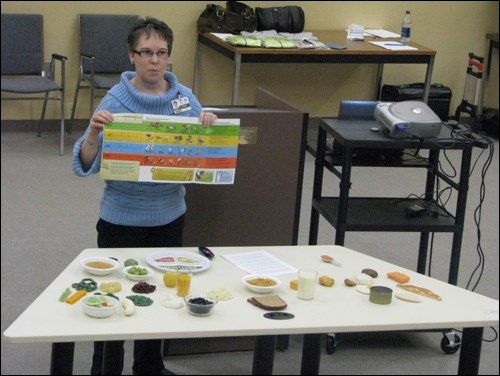Information and misinformation. Truths and untruths.
It's clear arthritis sufferers in the Battlefords, like everywhere else, have questions about a disease they've heard more than one answer for, and would like to see all the conflicting information sorted out.
Approximately 30 local residents turned out for a session addressing arthritis held in North Battleford last week. Presented by the Arthritis Society, Saskatchewan Division, the session, held in the North Battleford Public Library lecture theatre, featured information on diet, exercise and medications.
The afternoon's question and answer periods made it apparent arthritis sufferers are frustrated with a confusion of conflicting recommendations, anecdotal advice, long held beliefs and newly introduced theories as they seek to relieve their pain and maintain or improve their mobility.
One audience member asked, "How do you sift the truths from the untruths?"
Theresa Bachetto, dietician with the Prairie North Health Region, said, "It's tricky."
She encouraged arthritis patients to eat a healthy diet, following the Canada Food Guide, emphasizing getting enough of the good Omega 3 fats and looking for a variety of colourful vegetables for their antioxidants.
There is no special diet for arthritis treatment, she said, but the told the audience to listen to what their bodies are telling them. While there is no research to prove that tomatoes, for example, can worsen arthritis symptoms, if that appears to be the case, then try avoiding tomatoes.
Be careful, she cautioned, when deciding to exclude foods. It could do more harm than good.
Audience members had questions regarding vitamin requirements and using supplements.
While there is confusing information on whether or not to use supplements, said Bacchetto, understanding Canada Food Guide's recommended daily requirements can help make it easier. If those requirements are not being met by one's diet, it may be helpful to use supplements. She encouraged arthritis patients to seek advice from a doctor, pharmacist or dietician to help make those decisions. Often, it's important to ask why a need such as iron is not being met, and address that underlying cause.
In terms of weight loss and management, Bacchetto noted the loss of one pound can relieve four pounds of pressure off a joint.
Addressing medications and treatment was Darren Erbach, pharmacist with Fisher's Drug Store in North Battleford since 1997 and a member of the Pharmacists' Association of Saskatchewan's Professional Practice Committee.
He explained the use of treatment, including medication, as having the goals of controlling disease activity, controlling pain and maintaining quality of life.
"There's a lot of information out there, and misinformation out there." he said.
He explained the use of medications such as acetaminophen, non-steroidal anti-inflammatory drugs (NSAIDs), disease modifying anti-rheumatic drugs (DMARDs) and biologic agents, which suppress the immune system, and their side affects as well as some history on medication changes and research.
Not all medications require prescriptions, he said, such as glucosamine and chondroitin, and many of these are worth trying. Even topical treatments can be effective, he said, adding the important thing to remember is to look for products manufactured by reputable sources and that meet Canadian standards of safety.
Not all treatment is about medication. Erbach said it's important to exercise to reduce pain, prevent further damage, maintain weight and strengthen muscles, all of which are beneficial to arthritis patients. Protecting oneself by taking breaks from heavy exercise when necessary, and using tools and proper lifting techniques is also important.
Pain control can be assisted by relaxation techniques and even electrical therapy for certain joints, he said.
Of course, surgery is also a treatment for arthritis in some cases, he said, explaining some of the procedures that can be done to relieve pain and increase mobility
Exercise was further addressed by Marsha Rewerts, physical therapist with Prairie North Health Region.
Rewerts said encouraging movement as a treatment for arthritis has increased mobility among today's arthritis patients as compared to years past.
The worst thing to do for arthritis, she said, is nothing. Including following surgery.
People used to think a joint that hurts from arthritis shouldn't be moved, but that's not the case, she explained.
She used the rule of thumb of exercising or not according to whether pain is better, the same or worse as a result. If it's the same or better, move it. If it's worse, don't.
Arthritic people get the same benefits as others when it comes to exercise, said Rewerts. Joints receive nutrition from exercise (since there is no blood in our joints to feed them), resulting in stronger bones, stress relief, better sleep, improved mood, more endurance and energy, less risk of heart disease, stroke and some cancers. Exercise also improves balance, which can avoid falls and the injuries that result from them. These injuries, said Rewerts, are a significant cost to the health care system.
Sondra Livingston of the Arthritis Society's Saskatoon office, who hosted the afternoon, shared a balancing exercise with the audience, challenging them to stand 30 seconds on each foot once a day as a way to improving balance and building core and leg muscle strength.
She thanked the presenters as well as Kellie Heidel, Live Well co-ordinator with the Prairie North Health Region for making the session possible.

.png;w=120;h=80;mode=crop)

.png;w=120;h=80;mode=crop)
